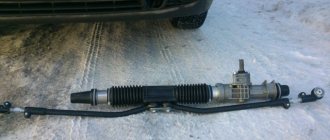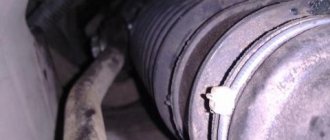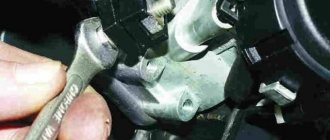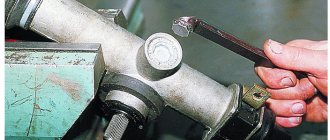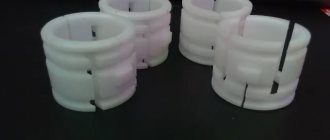The steering rack is the main element in the steering mechanism of the vast majority of cars. Due to the steering rods and steering tips attached to the rack, the turning force is transmitted to the wheels when the steering wheel is rotated.
Regardless of whether the steering is equipped with power steering (hydraulic power steering, electric power steering or hydroelectric power steering) or not, the steering rack continues to be a key element.
During operation, the driver may notice the following:
- the steering rack knocks when driving over bumps and when turning the steering wheel, the steering wheel began to “dangle” and pull out of your hands on bumps, the rotation of the steering wheel became too easy;
- if you shake the steering wheel in the “zero” zone (the wheels and steering wheel are straight), large play is noticeable, and the wheels do not respond to sufficiently significant angles of rotation of the steering wheel when deviating from “zero”.
These symptoms do not indicate problems with the steering and rack. In this case, it is often possible to minimize wear and tear without repairs. To do this, you need to adjust the rack by tightening it. Read more in our article.
When and why do you need to adjust the rack?
Steering noise and play are the main reason why the rack needs to be adjusted. As a rule, knocking and other symptoms appear as a result of the wear and tear of individual parts in the mechanism.
At the same time, this problem cannot be ignored, since the steering wheel loses its sharpness, a car with a loose rack becomes more difficult to control, etc. At the same time, adjusting the steering rack allows you to more or less eliminate the signs of wear of the mechanism. This means that if the rack does not have serious defects and is not damaged, it is enough to tighten the steering rack.
Background
An unpleasant characteristic dull knock appeared when driving this car, especially felt when driving over uneven roads. Hearing such a knock, Logan's owner stopped by one of the service centers, where he was diagnosed - the steering rack was knocking and required replacement.
In our service center, we decided to double-check the diagnosis of the previous “servicemen” to make sure that the steering rack really requires replacement.
If the rack is knocking, then first we will try to adjust the Renault steering rack and show you how to do it correctly.
Go
We lift the car on a lift and begin to inspect it.
First, we check for play by shaking the front wheels. Next, we check the steering rack itself. To do this, grab the body of the steering rod with your hand and rock it up and down.
There is undoubtedly some play when rocking; it is small, but it is there. However, the knocking noise we heard during the test drive was of a completely different nature. Upon inspection, we immediately saw the reason for the additional knocking, in addition to the knocking coming from the steering rack.
It is visually clear that there is a gap between the left bushing of the transverse stabilizer and the body of the subframe, which was the reason for the additional knocking. By shaking the body of the stabilizer, we make sure that there is play. When the car is raised, the knock is not heard, since the stabilizer is pulled back and the bushing on the right is still “alive”.
When the car is not on a lift, when rocking, a dull knock is clearly audible and precisely on the left side.
About the procedure for tightening the adjusting plug, you must clearly understand that this is not a panacea and will not eliminate the problem itself 100%. In addition to cases of knocking of the steering rack and large play, on cars with low mileage, when the pressed plug was unscrewed, only tightening and fixing it was necessary. Probably, it was poorly sealed, and there was little lock, which is why the plug gradually unscrews due to body vibration while driving.
How to make adjustments
Tightening the steering rack involves interacting with that part of the mechanism through which force is transmitted from the steering shaft to the rack. In general, the force after turning the steering wheel is transmitted using a helical or spur gear that meshes with a rack.
The gear is mounted on a bearing. In this case, the pressure of the gear to the toothed part should be tight (without gaps). For this reason, additional pressure springs are installed.
- If the rack-and-pinion pair is out of adjustment, it may require more effort from the driver to turn the steering wheel. In this case, you need to loosen the pressure of the gear to the toothed part, replace the lubricant, etc.
- If the rack is loose, there is a loosening of the fastening of the rack housing, the mounting bracket for the crankcase lever and the steering bipod, you can remove the knocking and play by tightening it.
It must be remembered that knocking and play can also occur due to wear of the rack or pinion, steering rods and other elements involved in the engagement of the transmission pair. If there are malfunctions, adjustment will not solve the problem. In this case, repair or replacement of the steering rack is necessary.
Moreover, even if you tighten the steering rack correctly, this is a temporary solution. After several tens of thousands of kilometers, the driver will again encounter play and knocking in the rack. In this case, secondary tightening of the adjusting nut is not recommended. It is necessary to carry out a complete repair of the steering mechanism or replacement of the rack.
Why tighten the rack on a VAZ-2114
Diagnostics of the steering rack and steering mechanism
Before tightening the steering rack on a VAZ-2114, it is worth considering the prerequisites that will tell you that it’s time to repair or tighten it.
In principle, AvtoVAZ guarantees a fairly long service life of the steering mechanism, namely ten years . However, we must understand that we are talking about ideal operating conditions. This assumes smooth asphalt roads, constant availability of high-quality lubrication in the rack housing and a gentle driving style.
Under normal operating conditions, this period is practically unattainable. Unimportant roads, poor quality of spare parts and often harsh operating conditions of the car lead to the fact that the mechanism makes itself felt much earlier.
The first symptoms of a faulty steering mechanism on a VAZ-2114
The first symptoms of a rack malfunction or the need for tightening are clear:
- Knocking noise under the hood in the area of the engine shield, especially when driving over uneven surfaces.
On a VAZ-2114, a knocking sound when driving through uneven sections of the road may occur due to a loose nut on the bolt that compresses the cardan clamp
The latter can be considered a glaring signal of malfunction and can lead to serious troubles while driving.
In this case, most likely, tightening the situation will not correct the situation, however, it is too early to draw conclusions, you can try to adjust it. This can be done in two ways - both on the car and with the rack removed.
Complete disassembly of the steering rack and replacement of the repair kit
In the second case, the adjustment is made after replacing the repair kit and completely repairing the mechanism. We will try to make do with little expense and simply adjust the gap in the gear-rack engagement , thereby eliminating backlash and knocking.
Adjusting the steering mechanism: features
Let us immediately note that steering racks installed from the factory usually require tightening, not loosening. Loosen the rack as part of adjustment or after repair. It is important to understand that the decision to tighten the rack involves a deviation from the initial factory settings.
Initially, the rack is configured at the factory in such a way that the pressure of the gear-rack pair is as tight as possible, while the steering wheel rotates easily and without effort. For this reason, you need to know how to tighten the steering rack. It should also be understood that tightening the steering rack does not always eliminate play and knocking, but you can reduce the play or knock of the mechanism.
We also note that if after the first tightening of the rack, after a short period of time, all the symptoms of the malfunction appear again, there is no need to tighten the steering rack a second time. As a rule, the first tightening removes play that occurs as a result of wear or deformation of the plastic bushings inside the mechanism.
Considering that the bushings are plastic, the first tightening “selects” the gap. However, if after such a tightening you tighten the rail again, the bushings will simply break or become completely deformed.
How to adjust the steering rack
Next, we’ll look at how to tighten the steering rack on a car. This can be done in a regular garage by driving the car into a pit or lifting it on a lift. The fact is that all work will need to be done under the car (taking into account the location of the steering rack).
- First you need to find a special adjusting nut on the rack body. On different cars, the nut can be in different places; the top of the nut is often covered by a cap.
- After removing the cap, you may also need a special tightening wrench. Often, if such a key is not available, you make it yourself.
- The next step is tightening the steering rack. During the tightening process, you must be careful not to overtighten the nut (remember, overtightening will damage the plastic bushings inside).
- Typically, no more than 1/3 of a full turn of the adjusting nut is required to securely lock the rack-and-pinion pair.
- In general, the optimal adjustment should be made so that the steering wheel rotates easily and freely, while play and knocking are minimized or completely absent.
After adjustment, it is important to check that the steering wheel rotates freely in both directions, without biting or additional force. It is also not allowed for the force on the steering wheel to change when it is rotated in any position. Normally, the force should be uniform.
We also recommend reading the article on how to change power steering fluid yourself. From this article you will learn when and why you need to change the oil in the power steering, what kind of oil to fill in the power steering, and also how the replacement is performed.
Of course, when adjusting, it is optimal to measure the steering play with a special device - a play meter. Taking into account the fact that such a device is usually not at hand, the tightening of the nut is determined by your own sensations on the steering wheel (the need for tightening or loosening).
Mandatory maintenance of system components
The stability of the front wheels is a prerequisite that affects the stability of the car. Any violation of the settings or failure of one part invariably results in a chain reaction leading to an imbalance of the entire system. That is why the manufacturer provides certain maintenance work
which include:
- cleaning from contaminants;
- wheel alignment;
- worm gear adjustment;
- steering wheel free play control;
- drive check.
Recommendations
After completing the adjustments, the rack should also be checked while running. It is important to pay attention to the fact that after turning the steering wheel, the steering wheel itself must return to the zero position (steering wheel straight) without driver assistance. If you have to turn the steering wheel by hand (the steering wheel does not return to zero), this indicates obvious problems with the rack (too tight the adjusting nut, wedging, etc.).
We also recommend reading the article about what electric power steering is. From this article you will learn about the features, as well as the pros and cons of electric power steering.
You can accurately check this nuance on a straight section of road with a good road surface without defects. Please note that when checking you need to be careful and careful! If there is no suitable site or you are not confident in your abilities, it is better to refuse these tests.
To check the steering return, just go through a turn and, at the exit of it, press the gas, briefly removing your hands from the steering wheel. If the steering wheel does not tend to return to the zero position and needs to be turned independently, then the nut on the rack may be overtightened and needs to be loosened.
How to remove play in the steering rack with your own hands
How to tighten the slats yourself:
- To adjust the rack and remove play, tighten the adjusting screw located in the end cover of the steering mechanism.
- Use the overpass pit in the garage. If such ideal conditions are not available, jacks can be used to tighten the rack. Be sure to secure the machine after lifting on the jackstands.
- Align the front wheels straight (level) before lifting the car body using jacks.
- In accordance with GOST of the Russian Federation, the play of the steering mechanism should not be more than ten degrees. Measure it with a backlash meter: there are both modern electronic and primitive devices.
- Tighten the adjusting screw slowly. During the process, check the steering wheel travel, as well as the presence of a knock in the column or play.
- If you think you have corrected the defect, carry out a sea test. Did you feel the steering wheel feel heavy when driving? Then loosen the adjusting screw a little.
You have succeeded in eliminating the problem if the steering wheel returns to the center position without difficulty and no knocking or play is detected.

